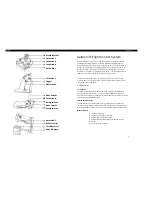
S.B.C. Elettronica S.p.A. - Engineering Division
HPDxxN – High Power User’s Manual
75
In this case (LUN=2) two bytes are transmitted for the data: the first byte is the mask containing
0 in the positions of the bits to change and 1 in the other positions; the second byte contains 1 in bit
positions to be set to 1 and 0 in the other positions. The address PAR corresponds to the parameter
(byte) in which one or more bits is to be modified. If the parameter is a word and the bit to be
modified is among the first 8 (b0...b7): PAR = parameter address; otherwise if the bit to modify is
one of the upper 8 (b8...b15): PAR = parameter a 1.
[CMD7] = parameter write broadcast message to all drives connected to the serial line; format:
[STX] [11100000] [LUN] [PAR] [D0] ... [Dn] [CHK]
The address of peripheral device (ADDR) must be zero.
Notes:
- Parameters shown on the display with decimals must be treated as integer values, e.g. 978.5 will
be read, and written, as 9785.
- All values preceded by the symbol $ are hexadecimal numbers.
- The value in square brackets is the basic unit (byte) of the message.
- To be considered valid all messages must be terminated within a clearly defined time interval
(time-out) which is a function of speed, and they must have correct parity and checksum.
- The drive responds to data requests or transmission only if the message is received correctly; if
the message contains an error, no answer will be transmitted. The only exception is message type
7, with which a datum is transmitted with a single message addressed to all drives connected to
the serial line.
Serial line initialisation and management
Drive serial communication can be enabled or disabled by means of bit b40.14.
The drive is factory set with b40.14=0, i.e. serial line disabled (default).
If you want to use the serial line first set the baud-rate in Pr.26; now set the serial address in
Pr.27; finally, enable serial communication by setting b40.14=1 and initialise using b42.3. At this
point you must save the configuration using command b99.15.
For parameter addresses and lengths refer to the relative table.
In the case of PLC instructions, each one occupies 2 or 4 bytes, the format of which is described
below.















































